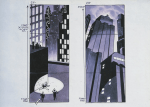Through this reliance on Netflix, I’ve seen a new television pantheon begin to take form: there’s what’s streaming on Netflix, and then there’s everything else.
When I ask a student what they’re watching, the answers are varied: Friday Night Lights, Scandal, It’s Always Sunny, The League, Breaking Bad, Luther, Downton Abbey, Sherlock, Arrested Development, The Walking Dead, Pretty Little Liars, Weeds, Freaks & Geeks, The L Word, Twin Peaks, Archer, Louie, Portlandia. What all these shows have in common, however, is that they’re all available, in full, on Netflix.
Things that they haven’t watched? The Wire. Deadwood. Veronica Mars, Rome, Six Feet Under, The Sopranos. Even Sex in the City.
It’s not that they don’t want to watch these shows — it’s that with so much out there, including so much so-called “quality” programs, such as Twin Peaks and Freaks & Geeks, to catch up on, why watch something that’s not on Netflix? Why work that hard when there’s something this easy — and arguably just as good or important — right in front of you?
Markets influence taste.
The New Canon – The LARB Blog











